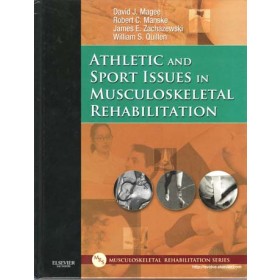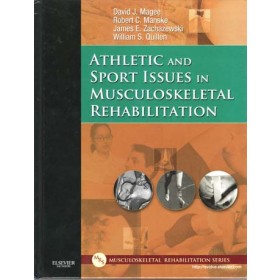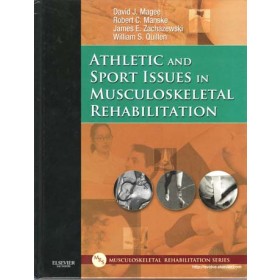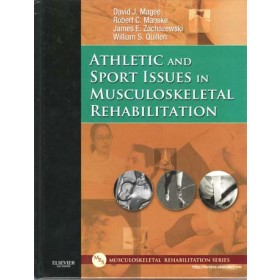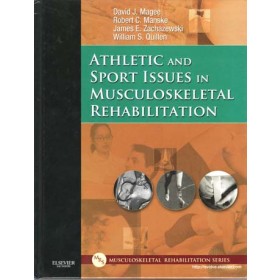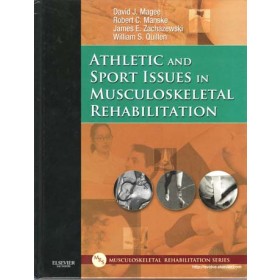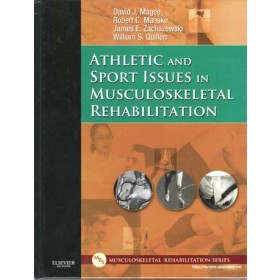Details
Athletic and Sport Issues in Musculoskeletal Rehabilitation: Module 4 (Electronic Download)
SKU: 754E
by David J. Magee, PT, PhD, Robert C. Manske, PT, DPT, SCS, Med, ATC, CSCS, James E. Zachazewski, PT, DPT, SCS, ATC, and William S. Quillen, PT, PhD, SCS, FACSM
These courses are offered in cooperation with Elsevier Health and utilize the textbook, “Athletic and Sport Issues in Musculoskeletal Rehabilitation” by David J. Magee, PT, PhD, Robert C. Manske, PT, DPT, SCS, Med, ATC, CSCS, James E. Zachazewski, PT, DPT, SCS, ATC, and William S. Quillen, PT, PhD, SCS, FACSM.
These courses provide expert insight and clear rehabilitation guidelines to help you manage injuries and special medical needs unique to your athletic clients. Contributions from leading physical therapists, athletic trainers, physicians and orthopedic surgeons give you a comprehensive, clinically relevant understanding of common sports-related injuries and help you ensure the most effective therapeutic outcomes. These courses are essential to everyone on the sports medicine team!
Module 1: covers preparation and prevention in sports medicine including the role of the sports medicine team, pre-participation physical fitness profiling, psychosocial aspects of youth sports and nutrition counseling and athletes.
Module 2: covers preparation and prevention in sports medicine including environmental considerations for sports, use of ergogenic aids in sports and sports drug testing issues
Module 3: covers applied biomechanics of cycling, golf, jumping and tennis
Module 4: covers applied biomechanics of soccer, running, swimming and baseball pitching
Module 5: covers management of sports injury and illness including delayed-onset muscle soreness, medical conditions in sport, dermatologic considerations in athletics and protective equipment in sports
Module 6: covers management of sports injury and illness including sports related concussions, traumatic injuries to the cervical spine, maxillofacial injuries and abdominal and thoracic injuries.
Module 7: covers special populations and epidemiology including the female athlete, musculoskeletal dance medicine and science, the athlete with disabilities, and selected rehabilitation needs of the masters athlete.
Module 8: covers applied biomechanics of common weight training exercises, taping for athletics and rehabilitation and applied sports injury epidemiology
Order this product and it will be available to you immediately after purchase for electronic download in the “My Downloads” section of your account after you have logged in. The download files will require Adobe Acrobat Reader to open. If you do not have Adobe Acrobat installed, you may download it at no charge from Adobe.com.
Course Length: 8.0 contact hours
Instructional level: Intermediate
This package contains the reading and testing materials for Module 4 only.
Athletic and Sport Issues in Musculoskeletal Rehabilitation: Module 4
Course Goals and Objectives:
Course Goals: This course is intended to instruct the student through self-paced study on providing intervention for the athlete in the specific areas of applied biomechanics of soccer, running, swimming, and baseball pitching.
Student Objectives:
At the end of this course, the student will be able to:
1. Understand four types of soccer kicks and ball velocity.
2. Evaluate the phases of a soccer kick.
3. Understand differences in soccer players/non-soccer players and lower extremity muscle activation during a kick.
4. Evaluate the body’s position during the backswing of a soccer kick.
5. Understand lower extremity positioning during side step cutting.
6. Analyze four types of cutting and the clinical pivot shift maneuver.
7. Evaluate the response of the body to heading in soccer.
8. Evaluate the possibility of overuse injuries in soccer.
9. Evaluate the relationship of hip joint stiffness and side step cutting.
10. Evaluate the pattern of contraction of cervical musculature and soccer heading.
11. Understand the relationship of four muscle groups and injuries to the adductor muscles and pubic symphysis.
12. Analyze four components of running.
13. Analyze the relationship of the lower extremity to foot strike and functional limb valgus during running.
14. Evaluate early and late pronation as it relates to running gait.
15. Evaluate the quadriceps firing pattern during running gait.
16. Understand vertical ground reaction forces and running.
17. Analyze supination and pronation in a runner.
18. Evaluate a runner with complaints of knee pain.
19. Understand the relationship of footwear and a supinatory foot.
20. Analyze rigid orthotics and the relationship to the foot
21. Evaluate pain and the freestyle swimming stroke.
22. Understand the position of the humerus during a swimming stroke.
23. Understand the phases of the freestyle swimming stroke.
24. Analyze four muscles as they relate to power during a swimming stroke.
25. Analyze eight muscles’ firing of patterns during the butterfly stroke.
26. Analyze eight muscles for power and endurance during the backstroke.
27. Analyze four types of swimming strokes as they relate to shoulder pain.
28. Understand four types of swimming strokes as they relate to fatigue.
29. Understand changes to the freestyle swimming stroke as it relates to upper extremity positioning.
30. Evaluate the need for stretching in swimmers.
31. Analyze the return to swimming after shoulder injury.
32. Evaluate the different phases of baseball pitching.
33. Evaluate twelve muscles and their relationship during the windup phase of pitching.
34. Evaluate the position of the lower extremity during lead foot contact of a baseball pitch.
35. Evaluate the activity of the supraspinatus throughout a baseball pitch.
36. Evaluate the position of the pelvis during a pitch.
37. Evaluate the relationship of the wrist and shoulder external rotation during the arm cocking phase of a pitch.
38. Understand the relationship of varus torque at the elbow to four different muscles.
39. Evaluate the position of the shoulder throughout a baseball pitch.
40. Understand the relationship of four different muscles during the deceleration phase of a pitch.
41. Evaluate the relationship of supination during four types of baseball pitches.
